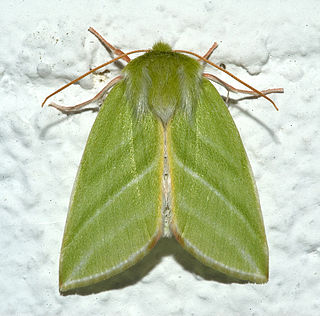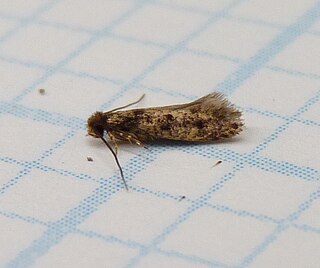Kuja is a genus of African moths of the family Thyrididae.

Nolidae is a family of moths with about 1,700 described species worldwide. They are mostly small with dull coloration, the main distinguishing feature being a silk cocoon with a vertical exit slit. The group is sometimes known as tuft moths, after the tufts of raised scales on the forewings of two subfamilies, Nolinae and Collomeninae. The larvae also tend to have muted colors and tufts of short hairs.

Gelechioidea is the superfamily of moths that contains the case-bearers, twirler moths, and relatives, also simply called curved-horn moths or gelechioid moths. It is a large and poorly understood '"micromoth" superfamily, constituting one of the basal lineages of the Ditrysia.

Gracillariidae is an important family of insects in the order Lepidoptera and the principal family of leaf miners that includes several economic, horticultural or recently invasive pest species such as the horse-chestnut leaf miner, Cameraria ohridella.
Metachanda is the sole genus in tribe Metachandini of moth subfamily Oecophorinae. Metachandini was originally described as family Metachandidae by Edward Meyrick in 1911, and at the time also contained the genus Chanystis, which is currently unplaced to tribe within Oecophorinae. It has also previously been described as tribe Metachandini of subfamily Gelechiinae.

Pterolonchidae is a small family of very small moths in the superfamily Gelechioidea. There are species native to every continent except Australia and Antarctica.
Catapterix is a small genus of moths in the family Acanthopteroctetidae, with species occurring in Europe and Central Asia. The genus was previously considered monotypic, with Catapterix crimaea as its sole known species, until the formal description of Catapterix tianshanica in 2016.
Leuronoma is a genus of moths in the family Gelechiidae. Most species of this genus are found in Africa.

Phereoeca uterella, known by the vernacular names plaster bagworm and household casebearer, is a moth species in family Tineidae. It occurs in tropical climates, where it is common in houses, and is presumed native to the Neotropical realm. In the Americas, it has been recorded from Brazil, Guyana, and the southern United States as well as the Virgin Islands and Trinidad, and tentatively identified from Tobago.
Novosia is a monotypic moth genus in the subfamily Arctiinae. Its single species, Novosia herbuloti, is found on Madagascar. Both the genus and species were first described by Hervé de Toulgoët, the genus in 1958 and the species in 1954.

Cadarena is a monotypic moth genus of the family Crambidae erected by Frederic Moore in 1886. Its only species, Cadarena pudoraria, was first described by Jacob Hübner in 1825. It occurs throughout tropical and subtropical Africa and in India.
Asplenia melanodonta is the only species in the monotypic moth genus Asplenia of the family Noctuidae. The species is found in Africa. Both the genus and the species were first described by George Hampson, the genus in 1916 and the species in 1896.

Casuariclystis is a genus of moths in the family Geometridae. It contains only one species, Casuariclystis latifascia, which is widespread. The range includes Borneo, the Andamans, Fiji, Rotuma Island, Vanuatu, New Caledonia, Hong Kong, the Ogasawara Islands, Kenya, Mauritius, Aldabra, and the Seychelles. The habitat consists of coastal areas, dry heath forests, limestone forests, oceanic islands, and dry secondary forests.

Eois is a genus of tropical moths in the family Geometridae. It was first described by Jacob Hübner in 1818. Caterpillars of Eois species are most commonly green with darker markings, but species with fully dark caterpillars also exist. They are specialized feeders associated with Piperaceae species, with sparse additional records on Chloranthaceae species. Adults are typically small, with diverse wing shape, color and patterning across the genus.
Cimitra is a genus of moths belonging to the family of Tineidae. Most species of this genus are found in Africa but Cimitra sechusella Walker, 1864 is found in Southeast Asia.
Coniostola is a genus of moths belonging to the subfamily Olethreutinae of the family Tortricidae.

Urodeta is a genus of moths of the family Elachistidae. The genus was originally assigned to the family Momphidae.

Perittia is a genus of moths of the family Elachistidae.

Pyrosoma atlanticum is a pelagic species of marine colonial tunicate in the class Thaliacea found in temperate waters worldwide. The name of the genus comes from the Greek words pyros meaning 'fire' and soma meaning 'body', referring to the bright bioluminescence sometimes emitted. The specific epithet atlanticum refers to the Atlantic Ocean, from where the first specimen of the species was collected for scientific description; it was described in 1804 by François Péron, a French naturalist.

Gracillariinae are a subfamily of moths which was described by Henry Tibbats Stainton in 1854.










